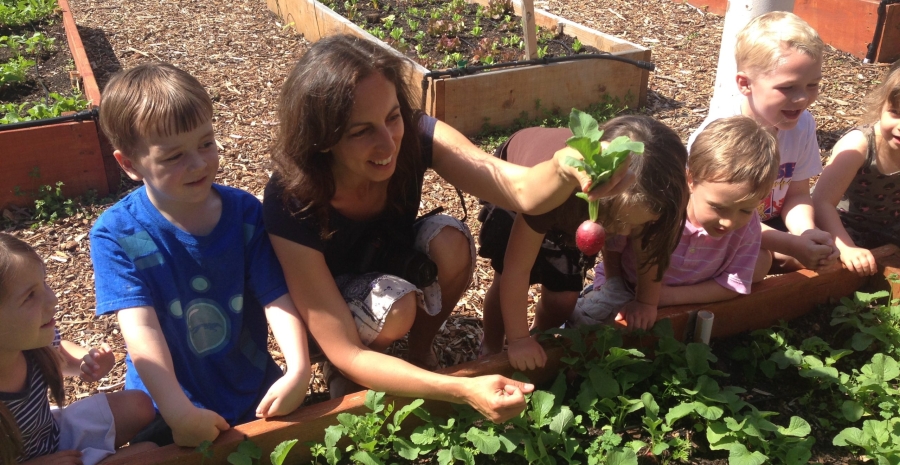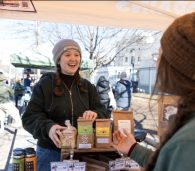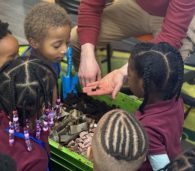Reflections Departing Education Director Jenn Mampara

In 2009, Bernadine Prince and Ann Yonkers, FRESHFARM’s founders, hired me to continue developing FRESHFARM’s first efforts to provide food education in schools, a program that Bernie brilliantly named FoodPrints and started developing in 2005. At Watkins Elementary on Capitol Hill, I worked with my friend and master gardener Barbara Percival, who volunteered to help me set up our first FoodPrints classroom. Unlike many of our partner schools today, there was no teaching kitchen. We used an abandoned science room and washed veggies and dishes in a sink with a pointy faucet designed to clean test tubes. This was a challenging setup for washing kale, lettuce, and basil from the school garden, but we made it work and began to dream about building a fully functional teaching kitchen.
 I came to FRESHFARM with training as a nutrition educator and experience as an elementary school teacher. Building the FoodPrints program at FRESHFARM was an unbelievable opportunity for me to combine my professional backgrounds and passions. I knew students needed more opportunities for hands-on learning and that almost every academic subject could be supported through experiences with food, gardening, and cooking. I also knew that kids weren’t getting nearly enough opportunities to experience the joy and beauty of the natural world or the satisfaction and empowerment that comes from preparing simple, nutritious meals that leave you feeling nourished and connected to those you share it with. Meeting these students’ needs became my north star, and I started developing FoodPrints at Watkins.
I came to FRESHFARM with training as a nutrition educator and experience as an elementary school teacher. Building the FoodPrints program at FRESHFARM was an unbelievable opportunity for me to combine my professional backgrounds and passions. I knew students needed more opportunities for hands-on learning and that almost every academic subject could be supported through experiences with food, gardening, and cooking. I also knew that kids weren’t getting nearly enough opportunities to experience the joy and beauty of the natural world or the satisfaction and empowerment that comes from preparing simple, nutritious meals that leave you feeling nourished and connected to those you share it with. Meeting these students’ needs became my north star, and I started developing FoodPrints at Watkins.
Amazingly, it now seems like all of Washington, DC shares this dream. We have a dynamic coalition of students, parents, school administrators, and city leaders working together to keep FoodPrints growing and thriving. We started in 2009 at one DC public school, working with 200 students in an empty science classroom. Seventeen years later, we are in more than 25% of DC public elementary schools, working with 8,000 students, and have seven beautiful teaching kitchens and two more currently under construction. This is so exciting! It’s good for students and families and gives me hope for the long-term health of our future citizens and our planet. It has taken time, but transformative change doesn’t happen overnight.
Looking back, here are the three most important things we did to make this happen.
1. We Embed FoodPrints Teachers in Schools
Our FoodPrints teachers are integral members of each partner school’s staff and return as part of the school community year after year. We hire, train, and match each FoodPrints teacher to a particular school, and we ensure they have what they need to create transformative hands-on learning experiences for students. Food education requires deep knowledge of food, cooking, gardening, classroom management, and teaching. It also requires time and resources to plan lessons, purchase ingredients, tend the garden, and manage the kitchen. Moreover, we work to ensure that FoodPrints teachers are a good match for their schools. For example, we pair FoodPrints teachers with schools in their own communities when we can, match Spanish-speaking teachers to schools serving sizeable Latino student bodies, and encourage our teachers to request placement at school communities they feel connected to.
2. FoodPrints Meets the Needs of Public Schools
Our food education program has been designed by educators who understand the complicated needs and realities of public schools. We tie our lessons directly to the academic curriculum at each grade level. We work flexibly with classroom teachers and school administrators around scheduling and learning approaches to engage with each unique community. We focus on social-emotional learning that aims to develop and maintain positive relationships and contribute to a more caring, just world. We engage families and provide low-barrier opportunities to volunteer at school and learn along with their children. And, perhaps most importantly, our approach to nutrition is to focus exclusively on affirming messages about and positive experiences with nutritious food. Students in our classrooms are so busy harvesting, cooking, studying, and eating fresh, local whole foods – there is no time or role in our program for food shaming.
We have accomplished so much, and there is more we can do. Tremendous potential exists for FoodPrints to collaborate with school food. Nationally, we invest over $18 billion in school meal programs each year, and research shows that connecting food education to school meals can dramatically increase the consumption of the nutritious food served in these meals.
3. Professional Development is Key
We run robust, ongoing training and professional development for our team. Leading successful FoodPrints programming is challenging and requires a wide range of expertise. Like DC Public Schools, we employ a team of instructional coaches to ensure our FoodPrints teachers can successfully customize program implementation to best serve their unique school community. Many of our staff come from and/or live in the communities where they work as FoodPrints teachers.
These three things have led to a stunning level of support and advocacy from students, school leaders, and parents who are passionate about FoodPrints and who advocate for it. Our city leaders are listening and have made sizable investments in the program from the city budget each year. This city investment has allowed FoodPrints to sustainably expand to schools in neighborhoods across the city. We are thrilled that leaders who often disagree agree that FoodPrints is worth investing in for our children.
 The remarkable investment by our Mayor and City Council in the DC budget makes this uniquely successful program possible. Over the past 20 years, we’ve built a program that is more deeply involved in schools in one city than any other food education program I know of. Our staff have full-time jobs and are fully integrated into their school communities. Students, parents, and administrators all love and value the program, with students regularly telling us that FoodPrints is their favorite school experience.
The remarkable investment by our Mayor and City Council in the DC budget makes this uniquely successful program possible. Over the past 20 years, we’ve built a program that is more deeply involved in schools in one city than any other food education program I know of. Our staff have full-time jobs and are fully integrated into their school communities. Students, parents, and administrators all love and value the program, with students regularly telling us that FoodPrints is their favorite school experience.
While this model is costly, it is truly effective. We have built a remarkably positive public/private partnership to support public schools, students, and families. We have an incredible champion in Chef José Andrés who helped us build our first teaching kitchen and has made significant financial contributions to support the program. I believe that FoodPrints is poised to be a national model for sustained, school-based food education across the country; we are already seeing examples of this in places like the Frankfort Independent School District in Kentucky.
So, after 17 fulfilling years of working on Foodprints, I leave the program in the capable hands of Beth Bacon, our new Director of Education and our incredible team. I am convinced of the program’s vital importance and excited for its vibrant future.


